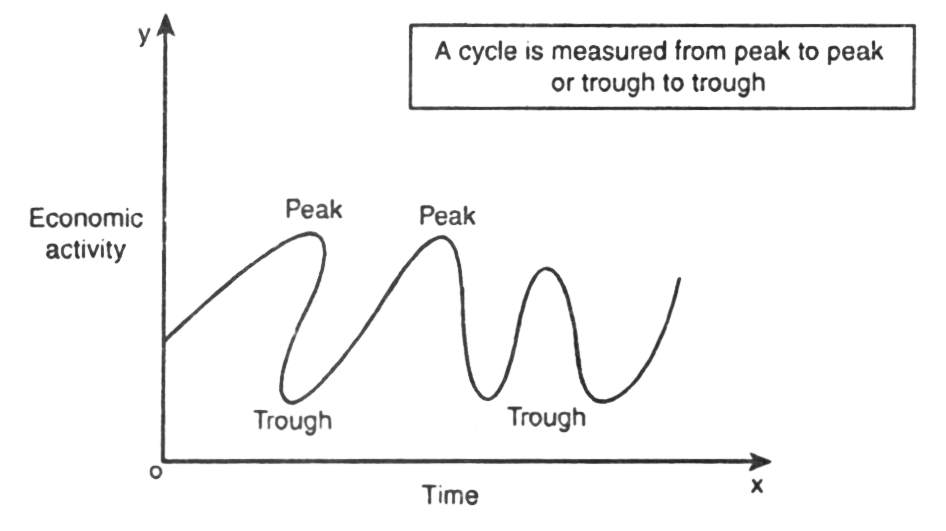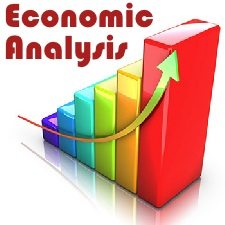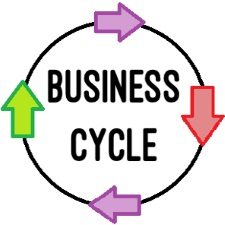Business Cycle – Meaning, Features & Characteristics
Table of Contents
Introduction
Every country, irrespective of the economic system prevailing, is subject to business and economic fluctuations. Certain business fluctuations are very short in duration, while there are fluctuations which have remained for over 3 to 4 years. Though both the short period as well as long period fluctuations are bad for the economy, the long period fluctuations in 1929 often cause irreparable damages.
Business fluctuations cause economic fluctuations. Hence, a country which is experiencing business prosperity or adversity, will also experience favorable or unfavorable economic climate. Normally, a period of prosperity is followed by a period of adversity or depression and vice-versa.
Economists have devoted their attention in studying the causes and consequences, and the extent of such oscillations in the economic activities of the nations. The study of alternating fluctuations in business activity, which is an inevitable part of economic development, is referred to in economics as Business Cycle or Trade Cycle.
Meaning of Business Cycle
The business cycle or trade cycle, as it is called in England, is an important feature of the working of the capitalist economy. The business cycle refers to fluctuations in economic activity that occurs more or less in regular time sequence in all capitalist societies.
The business cycle is nothing but upward and downward of economic activity, going one after another in a cyclical way. The business cycle is associated with sweeping fluctuations in economic activities such as production, prices, income, employment, exports, imports, etc.
The dynamic forces operating in the capitalist economy create various kinds of business or economic fluctuations. Some are abrupt, isolated and discontinuous, some are continuous, lasting for long periods of time in the same direction, while some are rhythmic and recurring in nature. Thus, according to their typical characteristics, fluctuations or movements in economic activity are commonly classified as:
- Secular trends,
- Seasonal fluctuations,
- Cyclical fluctuations and
- Random fluctuations.
However, among these, cyclical fluctuations have attracted the major attention of economists, as they create significant disturbances in the functioning of the economic system and their causation is not easily perceived.
Definition of Business Cycle
According to economists, the period of prosperity and adversity will occur alternatively in every economy with almost a definite regularity. As a result, the business expansion and contraction respectively will take place in an economy. The fluctuations are periodical, differing in intensity and changing in its coverage. Many economists have defined the term.
Wesley Mitchell stated that
Business cycles are fluctuations in the economic activities of organized communities. The adjective “Business” restricts the concept of fluctuations in activities which was systematically conducted on a commercial basis. The noun “cycle” bars out fluctuations which do not recur with a measure of regularity.
Keynes defined as
A Trade cycle is composed of a period of good trade characterized by rising prices and low unemployment percentage, alternating with a period of bad trade characterized by falling prices and high unemployment percentage.
Tinbergen considers the occurrence of trade cycle as
the interplay between erratic shocks and an economic system able to perform cyclical adjustments movements to such shocks.
Benham defines a trade Cycle as
a period of prosperity followed by a period of depression.
According to P.A. Samuelson,
The business cycle is a pulse common to most sectors of economic life and to diverse countries.
In the words of McNair and Meriam,
It is not the existence of ups and downs in the rate of activity in particular industries that constitute business cycles but rather the fact that the timing of these fluctuations tends to be roughly the same in many areas of business activity.
From the definitions, we can gather the features of trade cycle, that it occurs periodically, in a wave-like fashion and with varying magnitude, affecting the entire economy.
Features / Characteristics of a Business cycle
A business cycle is defined in various ways by different economists. For example, Mitchell defined it as a fluctuation in aggregate economic activity.
According to Haberler,
The business cycle in the general sense may be defined as an alternation of periods of prosperity and depression, of good and bad trade.
Cyclical Fluctuations Cyclical fluctuation are wave-like changes in economic activity characterized by recurring phases of expansion and contraction. These oscillating movements take the shape of waves from peak to trough and from trough to peak, as illustrated in the diagram.

One complete period of such oscillation is called a cycle. Cycles have a rhythm and are irregular. But they exhibit a recognized pattern of recurrent expansion and contractions.
From the definitions, we can gather the features of trade cycle, as follows:
1. Business Cycle occurs periodically — in a regular fashion.
This means the prosperity and depression will be occurring alternatively. But there need not be uniformity in the extent and magnitude. It may not be perfect by rhythmical in character.
2. Business Cycle is all embracing
The business cycle implies that the prosperity or depressionary effect of the phase will be affecting all industries in the entire economy and also the economics of other countries. It is international in character. The Great Depression of 1929 is an example of this.
3. Business Cycle is wave-like
It will have a set pattern of movements which is analogous to waves. Rising prices, production, employment and prosperity will become the features of upward movement. Falling prices and employment will become the features of the downward movement.
4. The process of Business Cycle is cumulative and self-reinforcing
The upward and downward movements are cumulative in their process. When once the upward movement starts, it creates further movement in the same direction by feeding on itself. This momentum will persist till the forces accumulate to alter the direction and create the downward movement.
When downward movement starts, it persists in the same direction leading to the worst depression and stagnation till it is retrieved to gain an upward movement.
5. The cycles will be similar but not identical
Different cycles and waves in the business cycles will be similar in general features, but they are not identical in all respects.


